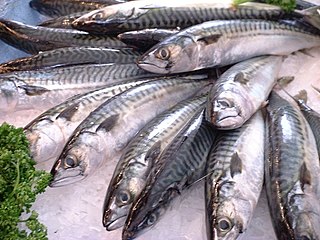
USS Mackerel (SS-204), the lead ship of her class of submarines, was the first ship of the United States Navy named for the mackerel. Mackerel and her near-sister Marlin were prototype small submarines which the Navy was exploring to replace the aging S-class submarines.

USS Mackerel (SST-1), originally known as USS T-1 (SST-1), was the lead ship of the T-1-class of training submarines. She was the second submarine of the United States Navy named for the mackerel, a common food and sport fish, and was in service from 1953 to 1973. She was one of the smallest operational submarines ever built for the U.S. Navy.

USS Marlin (SST-2), originally USS T-2 (SST-2), was a T-1-class training submarine in commission from 1953 to 1973. She was the second submarine of the United States Navy to be named for the marlin, a large game fish. Except for the first 25 early development pre-WWI subs, she was one of the smallest operational submarines ever built for the U.S. Navy.

The king mackerel or kingfish is a migratory species of mackerel of the western Atlantic Ocean and Gulf of Mexico. It is an important species to both the commercial and recreational fishing industries.

The Atlantic mackerel, also known as Boston mackerel, Norwegian mackerel, Scottish mackerel or just mackerel, is a species of mackerel found in the temperate waters of the Mediterranean Sea, the Black Sea, and the northern Atlantic Ocean, where it is extremely common and occurs in huge shoals in the pelagic zone down to about 200 m (660 ft). It spends the warmer months close to shore and near the ocean surface, appearing along the coast in spring and departing with the arrival of colder weather in the fall and winter months. During the fall and winter, it migrates out into deeper and more southern water, seeking warmer temperatures.

Wahoo is a scombrid fish found worldwide in tropical and subtropical seas. It is best known to sports fishermen, as its speed and high-quality flesh make it a prized game fish.
Snook, Snooks, or Snoek may refer to:

The Mackerel-class submarines were a pair of experimental prototype submarines built just prior to World War II and launched in 1940 and 1941. The two submarines were similar in size and capability to the S-class submarines built at the end of World War I, and had been ordered to test the feasibility of using mass production techniques to build small submarines. Until at least 1940 it was thought that mass production of fleet submarines would be impractical, and in any case small submarines could provide area defense for submarine bases. Once it became apparent that there would be sufficient production of the more capable Gato-class submarines, interest in the design waned and no additional small submarines were ordered. Submarine production standardized during the war on the Gato class and its successors, the Balao and Tench-class submarines. In some references, the Mackerels are called the "M class".
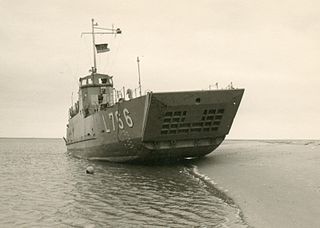
The Type 520 Barbe-class utility landing craft are small units of the German Navy used for landing or transporting troops, supply, equipment and also for coastal mine laying.
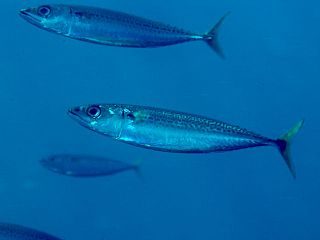
The blue mackerel, also called Japanese mackerel, Pacific mackerel, slimy mackerel or spotted chub mackerel, is a fish of the family Scombridae, found in tropical and subtropical waters of the Pacific Ocean from Japan south to Australia and New Zealand, in the eastern Pacific, and the Indo-West Pacific: the Red Sea, the Persian Gulf, the Gulf of Oman and the Gulf of Aden, in surface waters down to 200 m (660 ft). In Japanese, it is known as goma saba. It typically reaches 30 cm (12 in) in length and 1.4 kg (3.1 lb) in weight.

A tabby is any domestic cat that has a coat featuring distinctive stripes, dots, lines or swirling patterns, always together with a mark resembling an 'M' on its forehead. Tabbies are sometimes erroneously assumed to be a cat breed. In fact, the tabby pattern is found in many breeds, and is a genetic landrace common among the general mixed-breed population. The tabby pattern is a naturally occurring feature that may be related to the coloration of the domestic cat's direct ancestor, the African wildcat, which—along with the European wildcat and Asiatic wildcat —has a similar coloration. A genetic study found five genetic clusters from tabbies to be ancestral to wildcats of various parts of the world.

Scomberomorini is a tribe of ray-finned saltwater bony fishes that is commonly known as the Spanish mackerels or seerfishes. This tribe is a subset of the mackerel family (Scombridae) – a family that it shares with three sister tribes, the tunas, mackerels, and bonitos, and the butterfly kingfish. Scomberomorini comprises 21 species across three genera.

Great Mackerel Beach is a suburb about 43 kilometres north of the Sydney central business district, from 2016 in the local government area of Northern Beaches Council, Sydney, New South Wales, Australia, formerly part of Pittwater Council. It is on the western shores of Pittwater in Ku-ring-gai Chase National Park, beside Currawong Beach, and near Coasters Retreat and Palm Beach. The population was 36 at the 2016 census; the median age was 66, with an average of 0.3 children per family and an average of 2 people per household. The population was 301 at the 2011 census, and 103 in 2006.
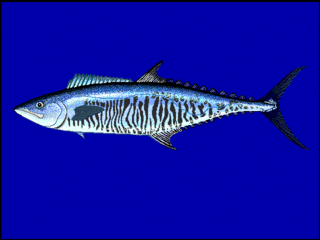
The narrow-barred Spanish mackerel is a mackerel of the Scombridae family found in a wide-ranging area centering in Southeast Asia, but as far west as the east coast of Africa and from the Middle East and along the northern coastal areas of the Indian Ocean, and as far east as the South West Pacific Ocean.
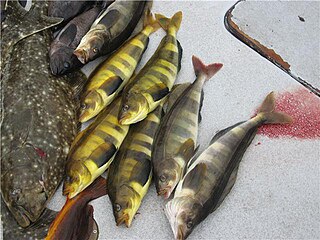
The Atka mackerel is a mackerel in the family Hexagrammidae. Atka mackerel are common to the northern Pacific ocean, and are one of only two members of the genus Pleurogrammus - the other being the Arabesque greenling. The Atka mackerel was named for Atka Island, the largest island of the Andreanof islands, a branch of the Aleutians.
Three ships of the Royal Navy have borne the name Mackerel, after the Mackerel, a name given to a number of species of fish:

The Chilean jack mackerel sometimes called the Inca scad, is a species of jack mackerel in the genus Trachurus of the family Carangidae. Since the 1970s, it has become one of the world's more important commercial fish species. High volumes have been harvested, but the fishery may now be in danger of collapsing.
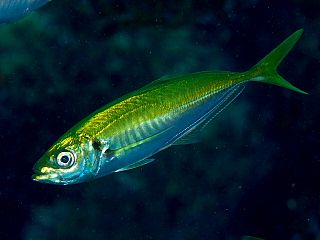
The Japanese horse mackerel is a species named after mackerel in the family Carangidae. Their maximum reported length is 50 cm (20 in) with a common length of 35 cm (14 in). They have a maximum reported weight of 0.66 kg (1.5 lb) and a maximum reported age of 12 years. They are found around the coast of Japan, apart from Okinawa Island, usually on sandy bottoms of 50–275 m (164–902 ft) deep. They feed mainly on small crustaceans such as copepods, and shrimps and small fish. They are similar to the yellowtail horse mackerel around New Zealand and Australia, apart from having more gill rakers and larger eyes.

